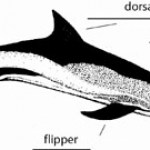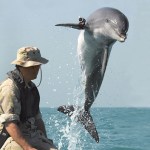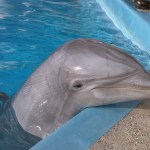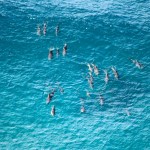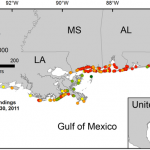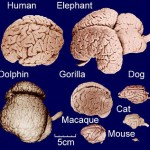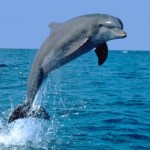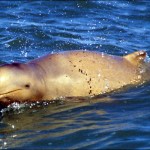A special thank you to reader Dr. Barbara Goodman, Professor of Physiology at Sanford School of Medicine of the University of South Dakota who sent me a story from The Scientist about sleep in animals complete with footage of a dolphin that was seen apparently "sleeping" (video posted on YouTube):
Why do animals sleep? This is a question with many potential answers. It is known that birds and mammals experience slow-wave and rapid eye movement (REM) sleep patterns. During the first pattern, slow waves with high amplitudes can be seen if measuring electrical…
dolphin
Research published in the Journal of Experimental Biology shows that noisy humans are impacting the physiology and behaviors of dolphins and whales. To compete against man-made noises, these animals are altering the amplitude, frequency or length of their vocalizations or repeat what they need to say with the hope of being heard. Dr. Maria Holt and colleagues studied a par of bottlenose dophins vocalizing and discovered that the oxygen intake of the animals increased as they raised their voices. The team then calculated the number of additional calories the dolphins…
Gray's paradox was originated by the zoologist James Gray in 1936 (J. Exp. Biol. 13: 192–199, 1936). The paradox questioned how a dolphin is able to swim fast (~10.1 meters per second according to his calculations) with what he saw as a limited ability to generate that much power. Therefore, he concluded that dolphins must have some mechanism or adaptation to reduce drag (Davidson College).
More recently, Dr. Frank Fish (West Chester University, Pennsylvania) was quoted in The Scientist saying, “To resolve the paradox was to assume that flow over the dolphin’s body is laminar,…
A new documentary from BBC called "Spy in the Pod" has captured what they claim to be footage of dolphins using puffer fish to reportedly "get high". According to a quote from the Daily Mail, "Zoologist and series producer Rob Pilley said that it was the first time dolphins had been filmed behaving this way." The toxins apparently have a narcotic-like effect on the dolphins.
The "Spy in the Pod" two-part series begins tonight at 8:00pm on BBC1.
Additional source:
Daily Mail
In honor of Veteran's Day, we must not forget to thank the dolphins (and more recently sea lions) that have been active members of the US Military. The US military used dolphins trained to find and disarm underwater mines in the Iraq War. Eight dolphins served as the first marine mammals in active combat as part of the "Special Clearance Team One." The dolphins worked alongside drones equipped with sonar, Navy SEALS, reconnaissance swimmers from the Marine Corps, and divers trained to disarm explosives. When the drones detected something suspicious, the dolphins were able to discern whether…
A virus is to blame for the deaths of hundreds of bottlenose dolphins along the East Coast of the United States:
Kai, a dolphin involved in the study, was able to recognize the whistle of a fellow dolphin that Kai had not seen in years. Image by: Jason Bruck
Another reason to marvel at dolphins. As a follow up to the previous blog on dolphins calling each other by name, new research from Dr. Jason Bruck at the Institute for Mind and Biology (University of Chicago) shows that dolphins have the longest memory known in animals. In addition to Kai, shown above, a dolphin named Bailey recognized the whistle of Allie, even though they had not seen each other in more than 20 years! I am fairly…
Image of bottlenose dolphin pod from www.deography.com, Dylan O'Donnell 2010
A new study published in the Proceedings of the National Academy of Sciences provides evidence that bottlenose dolphins (Tursiops truncatus) use "signature whistles" to identify and call each other by "name".
Dr. Vincent Janik at the Scottish Oceans Institute, University of St. Andrews and colleagues recorded the individual whistles of wild bottlenose dolphins traveling in groups (pods). Using the recordings, they developed computerized versions of the whistles that were missing the vocal…
A higher than normal mortality rate for bottlenose dolphins (Tursiops truncatus) in the Gulf of Mexico during 2011 has been found to correspond with the Deepwater Horizon oil spill as well as colder weather conditions during 2010 leading to an influx of colder water into the Gulf from snowmelt. From January through April 2011, 186 bottlenose dolphins were found ashore between Louisiana and Florida, 46% of which were calves. This number is nearly twice that of preceding years (2003-2010). Using tissues collected from the animals, the actual cause of death is still under investigation.…
Eric M. Johnson and I spent about 45 minutes discussing "evolutionary psychology beyond sex" last night, which you can see today on Bloggingheads "Science Saturday."
Or just watch it here:
Scientists thought they had a pretty good handle on the social interactions of bottlenose dophins (Tursiops). They've used the term fission-fusion dynamics to describe dolphin (and non-human primate) society and so far it has served researchers well. Fission-fusion societies among dolphins are characterized by two levels of social hierarchy: groups of two or three related males ("first-order alliances") which work together to guard one or more females from other males, and larger teams comprised of multiple related first-order alliances ("second-order alliances") which cooperate to "steal"…
The National Institutes of Health announced that by 2011 it will transfer almost two hundred chimpanzees from the Alamogordo Primate Facility in New Mexico to a lab in San Antonio, Texas, lab for use in invasive research. In 1995, the NIH announced a moratorium on the breeding of chimps in federally-supported labs, and as a result, scientists have developed alternative ways to investigate diseases. But there are still viruses, such as hepatitis C and HIV, that other species simply can't contract. This fact, some argue, makes it prudent to subject chimps to this sort of biomedical testing.…
Several weeks ago, BBC Earth contacted me to let me know about this awesome new website they were building: Life Is.
The website, created by Firefly Interactive and The Brooklyn Brothers, will showcase some of the best images, videos and stories that the BBC Earth Natural History Unit has accrued in over 50 years of expeditions.
From the recent Life to the ground-breaking Life on Earth, BBC Earth has been at the forefront of our desire to discover more about our planet. The site, Life Is, fully compliments this back catalogue of programming enabling the viewer to see the content as it was…
The perspective that whales, dolphins, and other such marine mammals should be afforded "human rights" has surfaced again.
I thought I'd revisit a post I wrote about this several months ago, from the archives, when this first hit the news after the AAAS conference in San Diego. So here's a modified, updated version of the original post.
The blogosphere is all a-twitter with talk of the recent commentary in Science that dolphins should be considered people. Well, sort of people. Non-human people.
On the heels of the incident at SeaWorld in Florida in which a trainer was killed by one of the…
Want to get experience working with marine mammals? The Dolphin Research Center, in Grassy Key, Florida, is looking for interns for the Fall semester, and the deadline to apply is next week!
The DRC is home to a pod of Atlantic bottlenose dolphins (you might recognize A.J. from my banner image, used with permission of course) and a group of California sea lions. While the DRC hasn't yet been hit by oil from the BP oil spill, they are monitoring the situation closely - this may be a great opportunity to learn a ton about marine mammal research and help in the conservation effort.
Check out…
A photograph and line drawing (left side) of the fossil dolphin Astadelphis gastaldii. The crescent-shaped line in the line drawing represents the bite of a large shark, with the red portions representing damage done directly to the bone. From Bianucci et al, 2010.
Shark attacks are events of speed and violence. When they have locked on to a prey item sharks seem to come out of nowhere, and though they can be quite gentle with their jaws (as on occasions when they are unsure about whether something is food or not) their ranks of serrated teeth can inflict a devastating amount of damage.…
A new species of dolphin dubbed the snubfin has been witnessed displaying some very unusual feeding behavior off the northern coast of Australia. Apparently the dolphins were witnessed chasing fish to the surface of the water and then streaming jets of water out of their mouths to round the fish up before eating them.
I'm more of a Copenhagen mammel, myself.
"This incredibly unusual behavior, first seen in Australia off the Kimberley Coast, has only been noted before in Irrawaddy dolphins, which are closely related to this species," Lydia Gibson of WWF Australia told the Northern Territory…
In the 1980's female dolphins were first seen using sponges as a foraging tool to protect their noses while digging at the ocean floor for prey. New research, however, conducted by a team from Georgetown University (go Hoyas, biotches!) has taken a much more comprehensive look at this use of tools by dolphins.
So they can use tools. But this dolphin has clearly not yet mastered the use of female contraception.
Professor Janet Mann of Georgetown looked at a population of bottlenose dolphins in Shark Bay in Western Australia to observe the sponging behavior. Only female dolphins were…
